So I bring to your attention a simple, but very long recipe for cooking ...

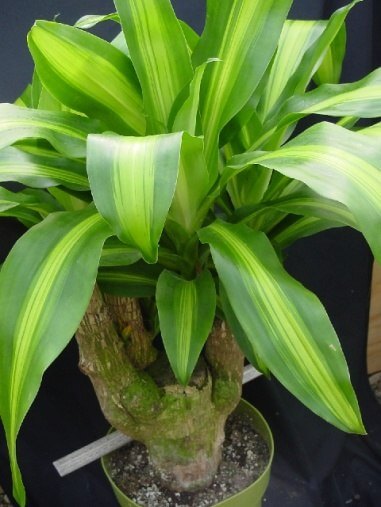
Want to have your own pet dragon, beautiful and friendly, unpretentious and fast growing. Then the dracaena plant is for you! It would be more correct to call her a female dragon, a dragon, because. The name of the plant comes from the Greek word drakaena, which means "female dragon". This is how the name of this flower is translated.
Dracaena is an extremely unpretentious plant, perfect for beginners in floriculture.
It is also called the dragon tree. Obviously, the inhabitants of the tropics of the Old World dracaena resembled a dragon with its extraordinary appearance and impressive size. Or maybe the red juice of dracaena from the Canary Islands seemed to people like dragon's blood? One way or another, there are many legends about this plant, one more romantic than the other. For example, according to Indian legend, in the distant past, a battle took place between an elephant and a dragon, in which both animals mortally wounded each other and fell to the ground. Their blood mixed, and where it dripped, the first dragon tree grew. According to another version, an evil dragon drank the blood of elephants until one of the elephants crushed the dragon with its weight. True, the elephant himself died at the same time, and at the place of the death of the elephant and the dragon, a tree grew from their blood - dracaena.
Another legend, of course, is about love. About the passion of a simple young man for the leader's daughter. The chief promised to marry his daughter to young man only if he manages to make a simple stick grow. Naturally, the young man planted a dracaena trunk in the ground, which soon formed a bunch of leaves at the top.
Finally, the ancient Greeks could not leave the attention of the amazing tree. According to their legend, the hundred-headed dragon Ledon, the guardian of the garden of the Hesperides, was killed by Hercules, who was performing his eleventh feat. Hercules got golden apples, and dracaena grew from the dragon's blood. The alleged location of the famous garden is the Atlas Mountains on one of the Canary Islands, and the dracaena is the famous species - Dracaena Draco, which grows there.
Dracaena is of great interest to any botanist. A biology student will definitely say that this plant is from the monocotyledonous class, is characterized by a very special structure of wood, it is arranged differently from most woody plants. It contains bundles of fibers, the stem of cereals has the same structure.
Origin
The origin of most species of dracaena is Africa and South Asia. Only one species grows in South America. Dracaena has become known to Europeans since ancient times. The scientific name of the tree was given by Carl Linnaeus.
The most common species in nature - Dracaena Draco - is an exceptionally hardy tree that can adapt to any conditions of existence. This dracaena withstands severe drought conditions. Its leaves are collected in a bunch to ensure that moisture is retained inside. The crown of the plant is arranged like an umbrella to create maximum area surface shade and do not allow the soil under the tree to dry out.
The most famous dracaena in the world - Drago Milenario - grows on about. Tenerife and is believed to be over 1000-2000 years old. No one knows what miracles this tree has seen during its long life, but the inhabitants treat it with undisguised respect and consider it a symbol of the island.
Fashion for dracaena appeared in the 90s. It was then that she began to appear in apartments and offices, preschool and school institutions. Oddly enough, dracaena is still popular today. Even the most "advanced" flower growers are not yet disappointed with the amazing vitality, rigor and elegance of this amazing plant.
My Dracaena Story
My relationship with dracaena is quite long and very successful, in any case, I have not yet managed to kill a single plant. In my opinion, it is hardly possible to kill a dracaena, in principle, even with a strong desire. Most species of dracaena are so unpretentious that they can grow without sufficient attention from our side.
I don’t even remember when I got my first dracaena. It was a very long time ago, in those days when dracaena had just begun to come into fashion. Naturally, the first species tamed by me was the well-known dracaena marginata, which is still the most popular species among amateur flower growers. It grows with me until now, there were absolutely no problems with this plant. After the dracaena reached an unprecedented height, and its trunk was bent (they forgot to turn in time relative to the sun), the plant had to be cut. Soon a new kidney appeared (though, unfortunately, only one), and the growth of the dragon continued.
The second type of dracaena, which has been growing with me for about 15 years, is fragrant dracaena. This plant successfully endured the most unfavourable conditions existence. She grew up in absolute darkness in the bathroom during the renovation, grew up in the bright sun of the southern balcony. By the way, under shading conditions, its appearance was the most impressive - a bright yellow stripe appeared, the plant looked like a huge, well-fed and contented broiler. In the conditions of the dark room, where my dracaena is now, it continues to grow and increase. It has reached such a gigantic size that, probably, the ceiling will soon have to be dismantled. I don't dare cut this beauty. True, the strip on the leaves is almost invisible, but the leaves are huge and wide. Yes, this dracaena also bloomed several times with small fragrant flowers (the smell resembles the aroma of cloves, a little sharp).
I have a dracaena deremskaya, while it is small, but it really wants to become big.
Most amazing view, this is still Godseff's dracaena. She looks like common plant with stem and leaves. When I bought it, I asked the salesperson to show me a "cute croton with polka dots". He laughed for a long time, because. my croton turned out to be a dracaena. Never had any problems with this plant either. It blooms regularly, however, the flowers, to put it mildly, are absolutely not impressive.
Finally, about one more type of dracaena, which entered my upbringing. This is Dracaena Sander. Probably the most unpretentious species, because. it can be kept in a vase of water at the back of the room. Water should be changed periodically and fertilizer added to it. This plant usually appears as curved sticks resembling bamboo (the bamboo stick at the top of the site is the body of my Sander Dracaena). True, this dracaena grows in a room for about 2-3 years and then begins to turn yellow from below. And once the process has begun, it cannot be stopped. The only way out for me was to cut off the top and root it in the soil. In the ground, Dracaena Sander grows without problems. True, it stretches out very quickly, dumps lower leaves and turns into a stick. In general, it loses its attractiveness. Often Sander's dracaena is sold in the form of different pyramids, intertwining compositions. I had such a pyramid, it also grows quickly, the plants that make it up gradually die off. Somewhere in 3-4 years, a couple of long branches remain from the composition. Maybe someone has a more successful experience of growing pyramids from Sander's dracaena?
Bloom
The flowering of dracaena cannot be called impressive, although some flower growers really like it. Blooming dracaena makes us delight rather from surprise, because. we are accustomed to perceive this plant as exclusively decorative deciduous, and suddenly it turns out that it also blooms. The inflorescence represents an ear or brush, and the flowers are not very large and colorless, usually located in funny balls. Their petals bend outward, revealing stamens sticking out in all directions. female flowers, in general, are ugly - green pistils and nothing more. Many species have fragrant flowers. Fragrant dracaena is especially prone to flowering.
Lighting
Dracaena, like the vast majority of plants, will prefer bright diffused color conditions, i.e. western or eastern window sill. Normal illumination is important for plants with brightly colored leaves. If such a plant is in the shade, get beautiful colour fail. However, dracaena with plain leaves grow remarkably on northern windows and in the depths of lighted rooms. Do not forget to regularly rotate the plant relative to the light source to form an even trunk.
Dracaena should not be placed in direct sun - in this case, the result will be the appearance of burns on the leaves.
You should be very careful when buying dracaena, because. sometimes an outwardly beautiful plant may have a completely rotted root.
Watering the dracaena should be moderate, i.e. The soil should dry out between two waterings. Excessive moisture is very dangerous for the plant, which can lead to rotting of the root system, which is especially likely when kept in the cold with a lack of light. At the same time, most species signal a lack of moisture with drooping leaves, which restore turgor soon after watering. With constant insufficient watering, the lower leaves curl, become covered with dark dots, turn yellow and fall off.
Fertilizer
Dracaena is fed with standard fertilizers for decorative purposes. deciduous plants about 1 time in two weeks during the period of its active growth. In winter, you can feed no more than once every one and a half months, but it is better not to fertilize at all, because. at this time, in most cases, the dracaena has a dormant period.
Dracaena needs regular hygiene procedures, its leaves must be constantly wiped with a damp cloth, and small plants are very useful to bathe in the shower.
Humidity
Air humidity does not play a big role for dracaena. It easily adapts to the dry air of the rooms. However, it is still better to spray the plant periodically, especially in winter with the heating turned on. Sometimes, in conditions of dry air, the tips of the leaves of the dracaena become dry and brown.
Temperature
Dracaena is quite thermophilic, it is desirable that the temperature in the room does not fall below + 18 ° C. Some resistant species (Dracaena draco, fragrant dracaena, D.hookeriana) can be kept at a temperature of +12°C in winter, but it is better not to allow the plant to become very cold. In any case, when the temperature drops, watering should be reduced. In summer, it is useful to take the plant to fresh air.
substrate
For dracaena, quite loose is suitable fertile soil from garden soil, sand, peat, leaf humus. You can use perlite and vermiculite. The substrate must be slightly acidic. Good drainage is required.
Transfer
Sometimes it is possible to distinguish dracaena from a very similar species - cordilina - only when transplanted. Dracaena has orange roots, while cordilina has white roots.
Dracaena is transplanted as it grows 1 time in 2-3 years.
Dracaena is very powerful root system, and the roots grow deep, so the plant requires a large and deep pot. Sometimes the lack of space for the root system can be the reason for the inhibition of the growth of dracaena. Once, having cut the dracaena, I assumed that now its root system would not need much space to provide moisture for a small amount of foliage and transplanted the plant into a smaller pot. The result was yellowing and drooping of the leaves. When I returned the dracaena to its original pot, its normal growth resumed.
For some species, the main difficulty in growing is insufficient branching. Unfortunately, it is unlikely that it will be possible to force branching, for example, Sander's dracaena. Dracaena bent also branches reluctantly, if cut off, usually only one apical bud wakes up. For better branching, it is imperative to put the plant in bright light, observe the correct watering regime, provide high humidity and top dressing with mullein with mineral fertilizers, and spray the stump with a solution of urea (1 g / l). 10 minutes after spraying, the solution should be removed with a napkin so that it does not accumulate in the sockets.
The reason for the drying of the tips and edges of the leaves can be dry air, draft, insufficient watering.
As a result of cold storage, soft twisted leaves with brown roots appear. Such a phenomenon can be observed even if the dracaena is left in a cold room for one night.
With excessive watering and cold content, rotting of the root system and death of the plant is possible.
Light dry spots on the leaves - most likely a sunburn.
Yellowing of the lower leaves of the dracaena is normal, usually the dracaena leaf lives 2-3 years. However, excessive too rapid fall of the leaves and exposure of the trunk indicates an incorrect maintenance of the dracaena: a lack of light or moisture.
Variegated dracaena leaves can become monotonous from a lack of light or from an excess of nitrogen fertilizers.
Rapid leaf fall (more than 4 per week), softening of the base of the trunk, wrinkling of the bark, rotting of young leaves indicates the imminent death of the plant. In this case, the only way out is to re-root the top.
The most common pests of dracaena are scale insects and spider mites.
When buying a dracaena, you should pay attention that its leaves have normal turgor, try to understand if the roots have rotted.
reproduction
Dracaena propagates by apical cuttings, which are obtained, for example, when pruning plants that are too tall. The top is rooted in boiled water, in which it is desirable to add activated charcoal for disinfection. It is best to propagate dracaena in the spring. When rooted in water, the cuttings may rot. Therefore, it is more efficient to root dracaena cuttings in wet sand, immersing the cuttings in the sand by 1/3 of the length. At the same time, stem cuttings with dormant buds can be laid horizontally on the surface of the sand, having treated the cuts with charcoal. The cuttings are covered with polyethylene and kept on a battery at a temperature not lower than +25°C.
Dracaena can be propagated by air layering.
To propagate dracaena by seeds, they must be soaked for about 5 days, changing the water every day. Then the seeds are sown in a mixture of peat and sand and the substrate is kept moist. best temperature for germination +28°С. Germination lasts approximately 30-40 days, sometimes up to 6 months.
Air cleaning
Dracaena are listed by NASA as one of the most effective air purifying plants. The plant serves as a real filter and purifies the air, for example, from formaldehyde.
If on vacation
Dracaena is a hardy plant, so it is likely that it will survive your absence for a short time. Even if you are not at home for a long time and the plant dries up all the leaves, however, it will have dormant buds that can resume growth with sufficient watering. Overwatering before departure is more dangerous, tk. can cause root rot.
By mistake, inexperienced flower growers call dracaena marginata a palm tree. With age, this species, growing in height, leaves scars on the trunk from fallen leaves. At the top of the flower are the leaves gathered together, which resembles a palm tree.
Dracaena sander is found in stores in the form of "lucky bamboo" or "bamboo of happiness." Dracaena has nothing to do with bamboo - this is a marketing ploy. Outwardly, Sander's dracaena looks like bamboo: it is a trunk with no large quantity leaves growing in clusters. The leaves are oblong-lanceolate, slightly curved. Bamboo of happiness is an unpretentious plant that fits perfectly into a Japanese or Chinese interior. It is grown in soil, hydrogel or simply in water, to which mineral fertilizers are periodically added.
Among the brightest representatives of the dracaena, the Godsef dracaena is distinguished, which reaches a height of 60 cm. Outwardly, it looks like a bush with pointed oval leaves covered with specks and specks. During flowering, fragrant yellowish-green flowers appear on it. The flower acquires great decorativeness when they appear on it.
When choosing the type of dracaena, consider which decorative properties are most preferable for you.
You can learn everything about dracaena from the following video:
Caring for all types of dracaena is simple: it is enough to comply with the minimum requirements regarding light, water and temperature conditions.
Dracaena prefers sunlight. The flower is better to put on the south side. During the heat, it is advisable to hide in the shade so that the leaves do not get a sunburn. The darker the dracaena leaves, the less sunlight the plant needs. Variegated plant species require less light.

In watering all types of dracaena, observe moderation. In summer, the flower is watered every two or three days, and once a week it is sprayed with a spray bottle. If the temperature has dropped below 15 degrees Celsius, the frequency of watering is reduced, since the flower is in a dormant state.
Prepare for transplant:
The success of growing dracaena depends on the right substrate. Prefer soil with a high peat content and an acidity of 6 to 6.5.
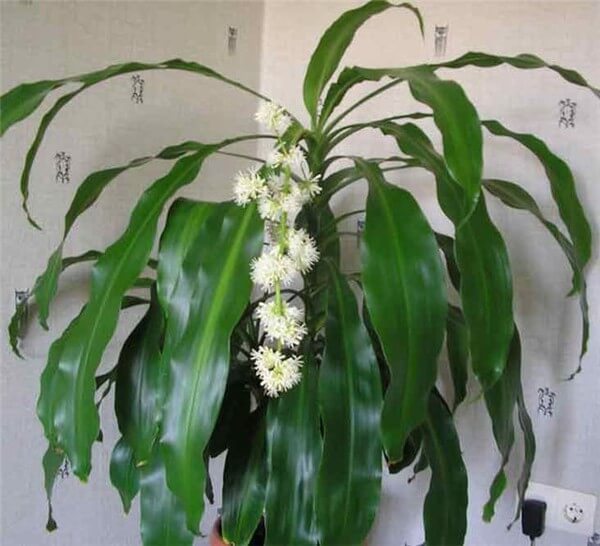
If you are preparing the substrate yourself, add leaf soil as it contains fertilizers and mineral salts. Use compost, turf and peat soil as a base. Adding sand will help prevent caking of the soil. Buying a ready-made substrate in flower shop, pay attention to the presence of all the listed components.
When choosing a pot, look at the size: it should be 2 cm wider than its predecessor. At the bottom there should be large holes for excess moisture to escape. Do not buy pots that are too voluminous, as the dracaena will begin to gain root, and not green mass.
The material of the pot can be anything: ceramic or plastic. Although it is believed that in ceramic pots, the roots and soil breathe, and the substrate dries out better.
Look at the roots. rotten roots need to be removed, and healthy - to leave. Be sure to put drainage at the bottom of the pot to avoid stagnant water.
Proper transplantation of dracaena will save you from possible problems in the future associated with growing a flower.
Most species of dracaena reproduce in the following ways:
With the help of seeds, only dracaena palm trees with green leaves are propagated. To do this, purchased seeds are soaked in a growth-stimulating solution. A day later, they are planted in prepared soil and cover the container with future shoots with a film. A greenhouse effect is created.
After two months, the first shoots will appear. When the shoots reach 6 cm in height, the future plant is transplanted into a separate pot. This method of reproduction takes a lot of time.
The success of propagation by cuttings depends on their choice. Only cuttings that have been cut from a non-lignified trunk are suitable. Its length should be 5 cm, and there should be kidneys on the sides. The cutting is stuck into the ground after cutting the bark from the side. The buds will open in a month.
The tops of dracaena are suitable for layering. They are placed in a container with a dissolved tablet. activated carbon. The cuttings are kept in water until they develop roots. The water is changed regularly. Then the dracaena is transplanted into a pot.
It is best to propagate by layering or tops. Reproduction by seeds takes a lot of time.
Its condition, growth and development depend on the correct care of the dracaena. Keep in mind that a healthy palm tree has a leaf lifespan of two years. Then it dries up and dies - this is considered a normal natural phenomenon. There are situations where you need to be vigilant.
Apical young leaves may turn yellow from excess and lack of moisture. It is necessary to ensure that when the earth dries up from above, and from below the earthen ball remains wet for some time.
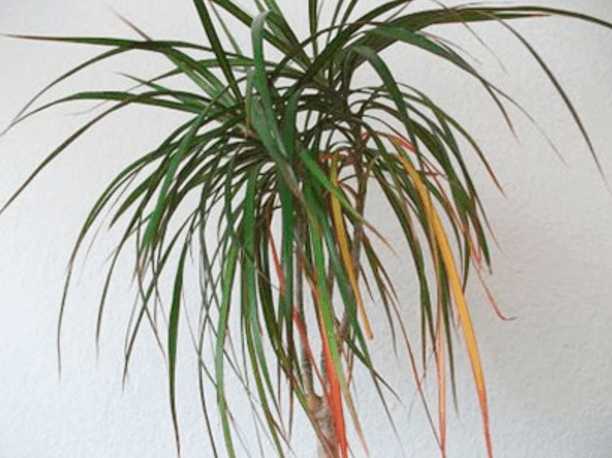
Dracaena leaves turn yellow
If the tips of the leaves turn yellow, this indicates the dryness of the soil. Dracaena needs additional spraying.
Brown spots indicate direct sunlight on the leaves. Provide the plant with diffused light.
The leaves may turn black and dry out if the dracaena long time do not transplant.
The formation of brown spots on the leaves with a light center indicates infectious diseases. Over time, the spots turn black when fungi multiply. This is treated by spraying the flower with fungicides.
For dracaena, hypothermia of the soil is extremely dangerous. To save the plant, there is only one way out - to cut off and root the stalk in the ground.
The best prevention of dracaena diseases is to create an optimal microclimate.
Dracaena will become your interior. The flower is quite unpretentious and responsive in care.
Noticed an error? Select it and click Ctrl+Enter to let us know.
Dracaena (or draceana) home was not always so. In ancient times, it grew in the wild African and Asian nature, and one of its species was familiar even to the Aztecs, who created a beautiful legend about it. The Aztecs are no more, but the dracaena has remained and, like most wild flowers, has long become a familiar part of the apartment interior and greenhouse for many flower growers. We will definitely tell you the legend associated with it someday; now, remembering that you are not reading this material in order to join the cultural heritage ancient civilizations, we will descend from heaven to earth and not only give you a description of this flower, but also tell you how to grow it correctly.
According to 2013 data, there are 113 species of dracaena (or "dragon", according to the dictionary of Vladimir Dahl) on Earth, although some sources bring this number to one and a half hundred. All this abundance is divided into two groups: varieties the size of a tree (the height of other representatives can reach up to 20 meters) and shrub species that grow in the wild as undergrowth. The plants of the first group have hard leaves and strong trunks, the second group has slender stems and flexible leaves shaped like a belt. In indoor decorative floriculture, only a small part of the second group of varieties is predominantly common, which we will talk about.
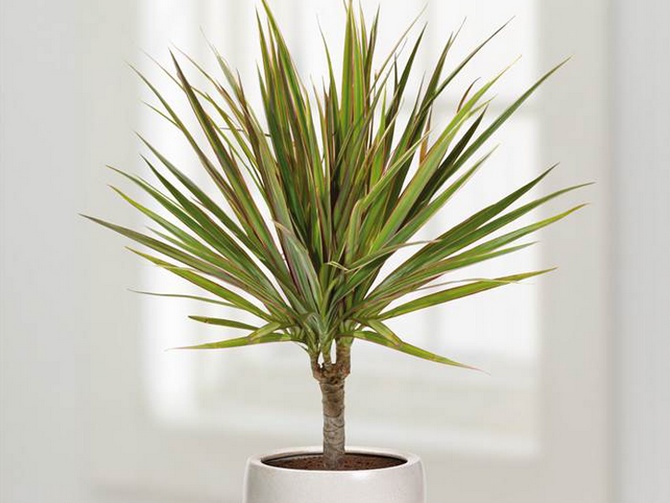
So, the following types are adapted to home conditions:
In the special literature, in relation to dracaena, one can sometimes find the term " false palm". The flower received this name because of its resemblance to cordilina, also belonging to this genus. However, experts do not advise combining these two plants together, even despite their obvious similarity.
It is widely believed that dracaena is easy to grow, but at the same time, all flower growers recognize the fact that there are species that are easiest to care for. These varieties are considered dracaena Godsef, marginata and dragon (Draceana draco). True, the ease of caring for them is relative and is manifested only in the fact that they do not need frequent spraying because they easily tolerate dry air. Otherwise, the same rules apply for their cultivation as for the cultivation of other types of dracaena.
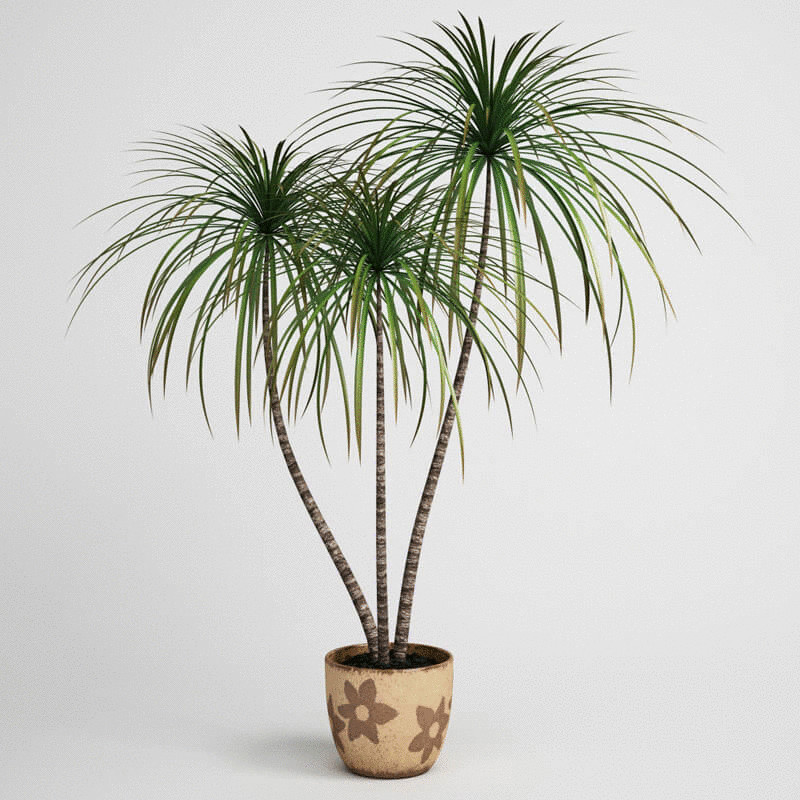
Since pruning and propagation of dracaena go hand in hand, we decided to give a description of these processes in a separate section, especially since in this case it is impossible to get rid of a couple of phrases.
Pruning is done in two ways: by rooting the air shoot and cutting off the top, followed by its rooting in a new pot. The first way looks like this:
And here is a description of the second method of reproduction:
If a large number of leaves grow at the top or they are too large, you can shorten them by a third.
In addition to the described method, dracaena is propagated by three more:
Only dark-leaved varieties can be propagated by the seed method, while variegated ones are propagated by vegetative methods. Its essence is as follows.
By cutting stems, dracaena is propagated in the following way:
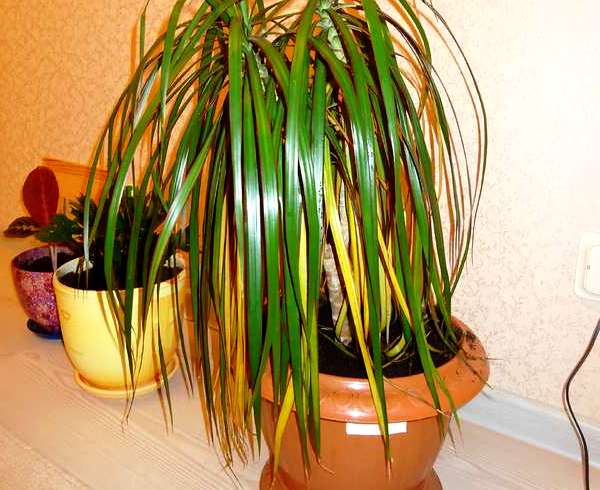
To propagate a flower with apical cuttings (or layering), the top of it is cut off 7-10 cm long and placed in a glass of water at room temperature, adding one tablet of activated charcoal to it for disinfection. After about three months, when the cutting takes root, it should be planted in the soil, where it will take root in two to four weeks. To stimulate growth, some flower growers use bottom heating and phytohormones.
In a similar way, the decorativeness of the dracaena can be improved, turning it from a "free-standing tree" into a pretty bush. If you set yourself such a goal, then the stalk with the roots started up in the way described above should not be planted in a separate container, but in a pot with a mother plant. It will begin to branch, and when the seedling grows, you should cut off the top of it and root it in the same way.
Like many other plants, the flower should be wary of scale insects, thrips, mealybug, aphids and spider mites. If you could not save it and your pet "fell ill", as a "treatment" you should wipe the leaves with soapy water, and after a day spray it with an insecticide (for example, "fitoverm" or "fufan" if the fight is against spider mites, and "actellik ", if you are dealing with a scale insect). If the dracaena was struck by a spider mite, then the soap solution should be hot, up to +50. But pests are not so terrible for dracaena as improper care for it. Below we will give you a description of the most common signs of improper flower maintenance.
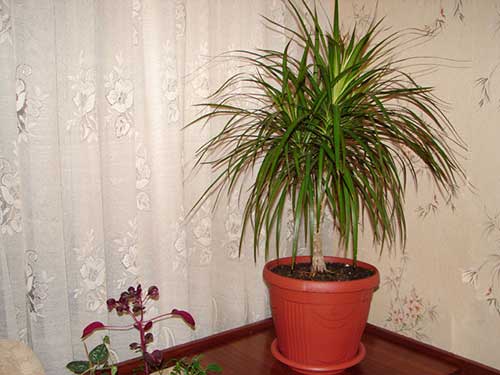
In addition to bacteriosis, some others can lie in wait for dracaena. infectious diseases- in particular, alternariosis, phyllosticosis and light brown spotting. This usually happens with old flowers, which are carelessly taken care of. The method of struggle consists in spraying the plant three times with fungicides (for example, a solution of foundationazole at the rate of 1 g per 0.5 liters of water) every 10 days.
"False palm" grows slowly, but is distinguished by longevity. Depending on how you take care of her, she will be able to delight you with her appearance from 5 to 15 years. If you propagate it in a timely manner, then this period will increase significantly and, perhaps, you will even be lucky to see how this amazing native of the tropics and subtropics blooms.
dragon tree, lucky bamboo, a tree of happiness, a false palm - all these are the popular names of dracaena - a plant that has gained immense popularity throughout the world.
According to the botanical classification, Dracaena (dracaena) is common name genus of the Asparagus family (lat. Asparagaceae). The genus Dracaena was singled out separately not so long ago, previously the plants were assigned to the Agave subfamily. From 40 to 150 plant species belong to the genus Dracaena. Moreover, despite belonging to the same genus, these plants are completely different in their own way. appearance: from huge trees and succulent shrubs to small indoor species.
In the wild, dracaena can be found in hot tropical and subtropical regions - Africa, India, South America. Socotra Island, for example, is famous for its Dragon's Blood Dracaena (Dracaena cinnabari). These huge trees are interesting feature: when the bark is damaged, bright red juice begins to ooze, resembling blood, hence the popular name of the plant. The locals use the juice as a medicine. Unfortunately, there are not many "Dragon's Blood" trees left in nature and now they are carefully protected.
About 15 species of dracaena are grown at home. All of them differ both in size and appearance, and in the requirements for the conditions of detention. Exist unpretentious species capable of withstanding harsh conditions: dry air, rare watering. Such dracaena are often grown in offices - where it is not possible to devote much time to the plant. And there are species suitable only for greenhouse cultivation: large and demanding to care for.
Here are the most popular home dracaenas:
1. Dracaena bordered, Dracaena Magenta(lat. Dracaena marginata) is a plant that can be found in almost any flower shop. Represents perennial with a stiff and fairly thick stem. The leaves are narrow, lanceolate, collected in a dense rosette, located at the top of the trunk. Depending on the variety (Tricolor, Bicolor), the leaves may have stripes of reddish or yellow-green color, there are varieties with uniformly colored leaves. Practically does not bloom when grown indoors.
The plant is unpretentious, but demanding on the location - it is necessary spacious room, since the bordered dracaena can reach a height of 2.5 meters. In no case should the leaves be damaged, as the dracaena can stop its growth.
D. bordered
2. (lat. Dracaena sanderiana), it is this dracaena that is popularly called the Bamboo of Happiness (Lucky Bamboo), according to the teachings of Feng Shui, such a dracaena brings good luck and success to its owner.
Outwardly, the plant really resembles bamboo, but it has nothing to do with bamboo. In the wild, Dracaena sander is a small plant growing up to 1m tall with slender shoots and narrow, bright green leaves.
Sold in florist shops, Dracaena Sander usually has a bizarrely curved stem in a spiral. This form is given to the plant forcibly: a young shoot is placed in a curved tube. As it grows, the stalk of the dracaena takes the form of a tube.
[!] Subsequently, such an artificially grown dracaena will again return to its natural form - the usual straight stem.
Due to the soft pliable stem, dracaena are often intertwined with each other and create bizarre compositions. Such manipulations are possible only with a young plant; as it grows older, its table becomes stiff.
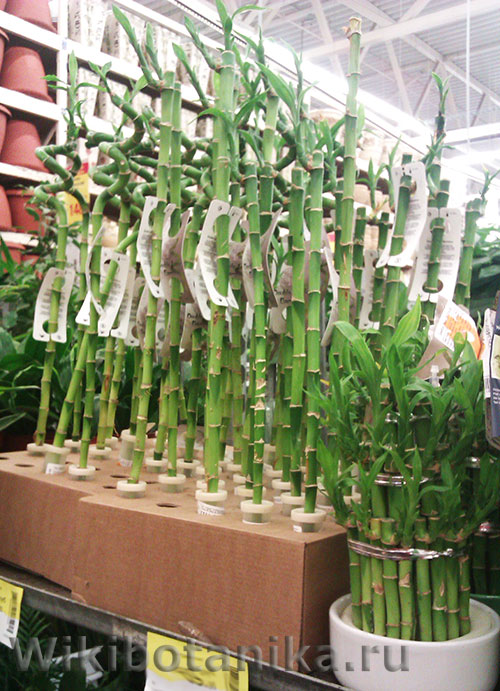 D. Sander
D. Sander 3. (lat. Dracaena fgagrans) - an evergreen plant with a long, thick trunk and fairly large leaves. As the plant matures, the trunk of the fragrant dracaena becomes stiff, branches and becomes bare. In this case, the leaves usually remain only at the top of the trunk. Such a spectacular appearance gives the dracaena a resemblance to a palm tree.
[!] Despite the sufficient thickness, the stalk of fragrant dracaena needs support.
In its natural environment, the plant can reach six meters in height, under conditions home growing- no more than 1.5 meters.
The fragrant dracaena received its botanical name for the pleasant smell spread by the flowers of the plant, which resembles the smell of fresh grass. Dracaena flowers are small, usually white or light green. Unfortunately, at indoor cultivation dracaena almost never blooms.
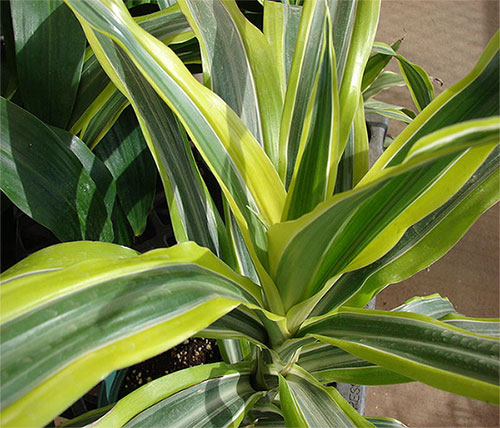 D. fragrant
D. fragrant 4. (lat. Dracaena deremensis) - as well as fragrant dracaena - a plant with a thick trunk, woody as it grows. The leaves are narrow and rather long, usually bright green in color with lighter longitudinal stripes. The leaves of the plant form a dense rosette at the end of the trunk.
In some sources, dracaena deremskaya is not identified in independent view, and is considered a subspecies of fragrant dracaena. indeed, these plants are very similar and differ only in the shape of the leaves.
 D. deremskaya
D. deremskaya 5. Unlike the previous species, (lat. Dracaena surculosa, Dracaena godseffiana hort) is completely different from the rest of the dracaena and rather resembles a ficus.
Dracaena Godsef is a shrub with a large number of rather thin erect stems. Leaves original form- ellipsoid, with a characteristic pointed end, in the natural environment can reach 16 centimeters in length and 5 centimeters in width. Leaf color - dark green with lighter spots irregular shape. The flowers of the plant are small, light in color, collected in inflorescences of several pieces. Like the rest of the dracaena, at home, Godsef's dracaena blooms extremely rarely.
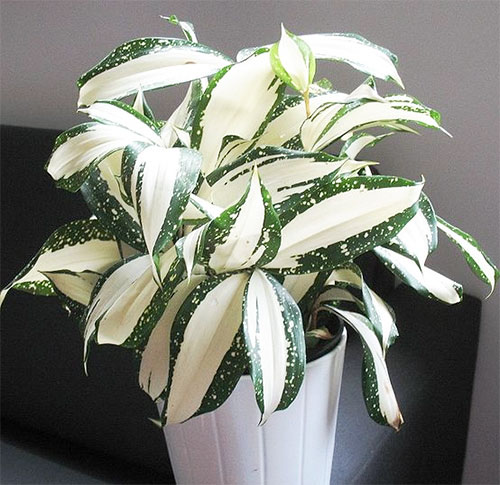 D. Godsefa
D. Godsefa 6. (lat. Dracaena reflexa) - pretty large plant common in Mauritius and Madagascar. In other parts of the world, it is grown in greenhouses and as a houseplant. Represents ornamental shrub with several trunks, often intertwined. The leaves, narrow and long, are collected in a rosette attached to the top of the trunk. characteristic feature plants - the bend of the tip of the leaf, for which it received the name dracaena bent.
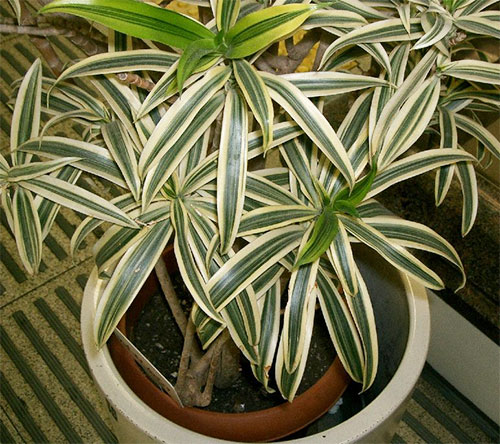 D. bent
D. bent 7. (lat. Dracaena goldieana Hort), a plant with a very short trunk and dense wide leaves. The leaves are painted dark green and have a pattern over the entire surface - transverse stripes of a lighter color. Dracaena Golden is beautiful and enough showy plant, but widespread in indoor floriculture it did not receive due to the peculiarities of the content: for growing Golden dracaena, high temperature and humidity. Such climatic conditions it is possible to create only in greenhouses and winter gardens.
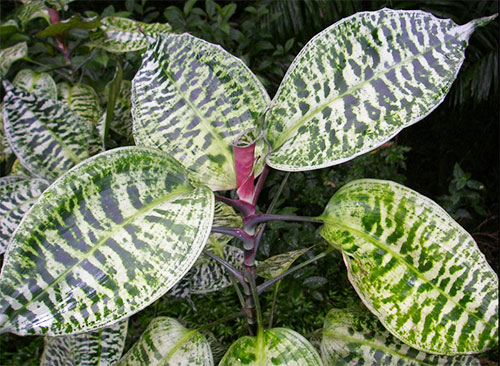 D. goldena
D. goldena Temperature, at which dracaena feels most comfortable - no higher than 28 ° C in summer and up to 18 ° C in winter. Summer temperatures should not be very high, dracaena does not tolerate heat very well. In winter, many species of this plant have a dormant period. At this time, it is important to reduce watering and lower the temperature. environment. The most preferred temperature for dormancy is cool, around 10-12°C. Such a winter temperature is difficult to achieve with central heating, so in winter it is best to keep the dracaena on a glazed loggia.
[!] Make sure that the temperature on the loggia does not fall below 12°С .
If the wintering of the plant takes place in a room with a high temperature, the dracaena may shed its leaves.
Optimal lighting for dracaena - penumbra without straight lines sun rays. There is a misconception that dracaena is. Unfortunately, this is not the case, and if you grow dracaena in a dark place, the plant will grow and develop poorly. The degree of illumination should vary depending on the color of the dracaena: species with patterned, variegated leaves require more light, monochromatic plants are less whimsical. The least demanding type of dracaena is fragrant dracaena with a monochromatic leaf color.
The best option for placing dracaena is a western or eastern window with shading during the hottest period. In an office environment, the plant can be additionally illuminated with fluorescent lamps.
Air humidity- a parameter that is not the most important for the plant. Dracaena can tolerate both dry and wet air. But, like many other plants, dracaena is very fond of spraying and warm showers. Showering and spraying must be carried out if the air temperature is at least 22 ° C, otherwise such procedures are contraindicated for the plant.
Watering dracaena is standard: frequent and plentiful in summer (the frequency depends on the drying of the earthen clod in a bowl), in winter it is more moderate. As for winter watering, it is important to correlate its frequency with the ambient temperature: if the dracaena hibernates at low temperatures, watering should be very rare (1 time in a month and a half at a wintering temperature of 10 ° C). Do not allow stagnant water and, as a result, rotting of the root, as well as excessive drying of the earth.
Dracaena transplant: young plants need to be replanted every year, adults - once every two years. The optimal time of year for transplanting dracaena is spring, at which time the growth period begins and the plant takes root better in the new soil.
The soil most suitable for dracaena should be light and quick-drying. Ready-made earthen mixtures for dracaena are presented on the floristic market. In addition, ready-made soil mixtures for palm trees are perfect. If you can not buy the mixture, prepare it yourself:
In all cases, it is useful to add charcoal (preferably birch) coal to the soil to prevent decay processes, and a little brick chips, which will collect excess moisture. Also, don't forget about good drainage - at least 1/10 of the height of the container for the plant.
Dracaena needs to be fed every two weeks during the period of active growth from April to September. During the dormant period, the plant should not be fertilized. For top dressing, complex mineral fertilizers for domestic plants are well suited: "Giant", "Rainbow" and others.
Reproduction of dracaena happens:
Dracaena leaves turn yellow- excessive dryness of the air, lack of nitrogen or other minerals in the soil
Dracaena leaves dry and fall - overflow and waterlogging of the soil. The plant is very sensitive to overflow and, if allowed, horse rot appears. Since the symptoms of overflow are yellowing and dry leaves, many flower growers believe that the dracaena lacks moisture and begin to water even more. It is quite natural that this only exacerbates the problem and the decay of the dracaena intensifies. Unfortunately, in most cases, dracaena with rotting roots is almost impossible to save. The least loss in this situation would be to cut off apical stalk, root it and grow a new plant.
home
Indoor plants photos and names- advice on care, cultivation, reproduction, watering indoor plants and flowers. Encyclopedia of Plants- photos, descriptions, features, plant care, growing flowers, pests and diseases of plants. garden flowers - all about flowers, garden plants, arrangement of a site and a reservoir. medicinal plants - photos, tips for collection and use, medicinal properties herbs and plants.
Dracaena care and cultivation. Dracaena - houseplant from the tropical regions of Africa and Asia, the Canary Islands. When choosing a dracaena for an apartment, it is necessary to take into account how much space it will be given, because. among the various types of dracaena there are giant and dwarf, and the usual form of the plant. In general, dracaena are considered not a difficult plant, but it all depends on the species.
The most unpretentious species - Dracaena fringed, dracaena dragon and Dracaena godsefa- they tolerate shading and low temperatures in winter. Other species are mostly quite demanding plants. Dracaena still need elementary care - wiping the leaves from dust, rejuvenating old plants, providing a dormant period that lasts from October to January.
Dracaena marginata (bordered) Dracaena marginata- a perennial plant growing up to 3 m in height, with a thick lignified stem, which usually branches little and becomes very bare. Leaves up to 50 cm long, about 1-2 cm wide, glossy, narrow-lanceolate. The color of the leaves is predominantly green, but depending on the variety, it may have yellow or red stripes. Dracaena marginata (Dracaena marginata) is a slow-growing plant, whose height can reach 3 m, the leaves are green with a narrow red border along the edge, in the variegated form the leaves have longitudinal yellow-red-green stripes.
This is one of the most common types of dracaena, and not only varietal species Dracaena marginata tricolor (with narrow red and yellow stripes) or Dracaena marginata colorama (with a wide red border) look spectacular, but also wild species Dracaena marginata - with green leaves and a reddish-purple stripe along the edge.
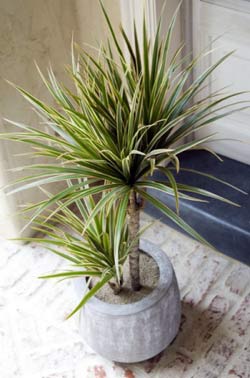 Wild plants of this species reach even 6 m, but in room conditions Of course, it is inconvenient to hold such a plant, so it is cut off, holding it at the right height. Caring for dracaena marginata is quite simple. It can be categorized unpretentious plants. It is believed that she is not capable of delivering any inconvenience to her master. You just need to follow a certain set of recommendations for caring for this flower. Note that dracaena marginata is practically not affected by any diseases and pests.
Wild plants of this species reach even 6 m, but in room conditions Of course, it is inconvenient to hold such a plant, so it is cut off, holding it at the right height. Caring for dracaena marginata is quite simple. It can be categorized unpretentious plants. It is believed that she is not capable of delivering any inconvenience to her master. You just need to follow a certain set of recommendations for caring for this flower. Note that dracaena marginata is practically not affected by any diseases and pests.
Dracaena fragrant Dracaena fragrans- has bright green leaves with a silver-gray stripe in the middle. It grows indoors up to 2 m in height. It blooms with fragrant white flowers. This is one of the best views dracaena. It is also not a very whimsical plant, which can withstand rather cool temperatures up to 10 ° C in winter.
Dracaena deremensis- slow growing plant, grows to 1.5 m and above. Leaves up to 50 cm long, about 5 cm wide, glossy, lanceolate. There is a variety with pure green leaves, but variegated varieties are more common. Some have one or more white or yellow stripes.
Dracaena Sanderiana Dracaena sanderiana- a compact plant growing up to 70-100 cm in height. It has gray-green, slightly twisted leaves, up to 23 cm long. There is a variety with a dark green border.
Dracaena Godseffiana Dracaena godseffiana- has an appearance uncharacteristic of other dracaena. It is a bushy plant with pointed, oval leaves covered in cream spots and speckles, but color and variety vary by variety. Grows up to 60 cm in height. It blooms at a young age with fragrant yellowish-green flowers, after which red berries sometimes appear.
Dracaena - CARE TIPS
Temperature: Moderate, not below 15°C, most dracaena prefer a cool overwintering at a temperature of 10-12°C.
Lighting: A bright place, partial shade, does not tolerate direct sunlight. Many consider dracaena shade plant, but in fact dark place she will vegetate. Intense light is needed for good growth and development. Variegated forms require more light than green leafed forms. If there is enough light in summer, then in winter the dracaena should be rearranged closer to the window, since in winter there is usually always not enough light. Dracaena grows well under artificial lighting.
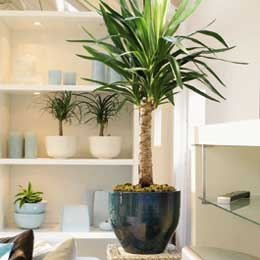 Watering: Plentiful in summer, moderate in winter, but subject to room temperature. Does not tolerate stagnant water in a pot or drying out an earthen coma. Dracaena are suitable for growing hydroponically.
Watering: Plentiful in summer, moderate in winter, but subject to room temperature. Does not tolerate stagnant water in a pot or drying out an earthen coma. Dracaena are suitable for growing hydroponically.
Fertilizer: During the growth period from April to August, every two weeks, dracaena are fed with special complex fertilizers for indoor plants. You can use "Rainbow", "Ideal", "Giant", etc.
Air humidity: Dracaena are resistant to dry air, but require regular spraying of leaves when kept in winter in rooms with central heating. Periodically give the plant a warm shower to wash off the dust and refresh the plant.
Transfer: Spring every two years. Soil - a mixture of heavy soddy and leafy soil, rotted manure or greenhouse land with the addition of sand. The roots of dracaena are more located in the upper layer of the soil, so they make a lot of drainage in the pot.
Reproduction: Apical cuttings (with the use of heteroauxin and heating of the soil), pieces of the trunk, at least 10 cm long, layering. If you cut off the top of the dracaena, you can put it in a jar of water, adding a few pieces of charcoal there, after about three months the roots will appear and the plant is planted in a pot. At the site of the top cut on the mother plant, new shoots from lateral buds will appear.
For the summer, it is better to put the dracaena in the garden or on the balcony, providing shelter from the wind and bright sun. Uniform lighting from all sides in the open air contributes to a more uniform leafing of the plant.
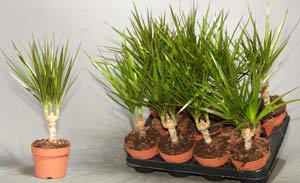 In appearance, dracaena are often confused with cordilins. To distinguish them, you will have to get the plant out of the pot. In dracaena, the roots are even and smooth in color from orange and yellow to light brown.
In appearance, dracaena are often confused with cordilins. To distinguish them, you will have to get the plant out of the pot. In dracaena, the roots are even and smooth in color from orange and yellow to light brown.
Broad-leaved dracaenas require more watering during growth than narrow-leaved dracaenas, as their leaves evaporate more moisture.
Dracaena respond very well to the periodic loosening of the top layer of earth in pots in spring and summer. This improves soil aeration. If the top layer of earth in a pot with dracaena is covered with a white crust on the surface - these are salt deposits from water and soil, then this earth must be removed and replaced with fresh one.
When transplanting dracaena add to fresh soil mix in addition to sand, pieces of wood (birch) coal and brick chips. On a bucket of earth, three handfuls of coal and 0.5 liters of brick chips. Pieces of coal prevent the development of rotting processes, and brick chips increase the friability of the soil and collect excess moisture, which is very important, because dracaena do not tolerate excess and stagnant water.
Variegated dracaena reproduce only vegetatively, and green forms, in addition, also by seeds.
Brown tips or leaf margins- too dry air, cold drafts or insufficient watering.
Brown spots on leaves- insufficient watering.
Leaves twisted, soft with brownedges- the temperature is too low, it may be warm during the day, and at night the temperature drops below normal.
Yellowing lleaves- with dry air, lack of nutrients in the soil (particularly nitrogen).
Lower leaves turning yellow- It is typical for dracaena to lose the lower leaves, while the upper part of the plant remains leafy. You can only rejuvenate the plant by cutting off and rooting the top. You can also plant younger plants in a pot to an old dracaena, in a group they will look more spectacular (see photo above).
Light dry spots on the leaves- too much light or sunburn. Dracaena needs shading from direct sunlight.
Shields: brown plaques on the surface of leaves and stems, suck out cell sap. Leaves lose color, dry and fall off.
Control measures. For mechanical cleaning pests, the leaves are wiped with a soapy sponge. Then spray the plant with a 0.15% actellik solution (1-2 ml per liter of water).
thrips- high temperature and low humidity contribute to the appearance. On the underside of the leaf, thrips lays numerous colonies, and light dots appear on the upper side of the leaf. As a result, the upper side of the leaf becomes grayish-brown with a silvery sheen.
Control measures. The plant should be sprayed, if necessary, repeatedly with insecticides (fitoverm, decis, actellik, inta-vir).
Aphids- dracaenas are also sometimes affected. They damage the leaves from the underside, the tops of the shoots. Damaged parts become discolored, the leaves curl, turn yellow and fall off.
Control measures. Spraying with derris, fitoverm, decis, actellik, inta-vir. In case of severe damage, repeat the treatment.
1. My dracaena leaves are turning black every day, and it seems that it does not grow at all. I spray it every day and wipe the leaves once a week, and water it only when the ground is completely dry.
Answer: Ta 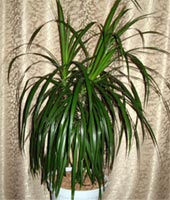 something can happen if you have a plant in heavy clay soil, or in light, but without humus and peat. This is hard to water, it is poorly wetted, shrinks. If nevertheless it is possible to moisten by immersion, it easily turns sour and dries for a long time. The plant cannot take it up with its roots. We need to change the soil. Carefully transplant into lighter soil containing equal parts of soddy, leafy soil, peat and sand. Suitable soil, by the way, remains black even when it dries out. Otherwise, buy ready-made, "Vermion", German or even universal primer. It is better, of course, if the sellers in the store can advise, but that's if you're lucky. Dracaena needs the soil to dry up on top, but the earthen lump never dries up!
something can happen if you have a plant in heavy clay soil, or in light, but without humus and peat. This is hard to water, it is poorly wetted, shrinks. If nevertheless it is possible to moisten by immersion, it easily turns sour and dries for a long time. The plant cannot take it up with its roots. We need to change the soil. Carefully transplant into lighter soil containing equal parts of soddy, leafy soil, peat and sand. Suitable soil, by the way, remains black even when it dries out. Otherwise, buy ready-made, "Vermion", German or even universal primer. It is better, of course, if the sellers in the store can advise, but that's if you're lucky. Dracaena needs the soil to dry up on top, but the earthen lump never dries up!
Answer: The main thing is not to fill the dracaena, you can water it less than once a week. The bright sun can burn it and the lack of light is also not very good. Before watering, it is advisable to check the soil with your finger. The need for water depends on many reasons: on the environmental conditions of existence at home, the time of year, the temperature and illumination of the room.
3. They gave dracaena Marginata Tricolor - Holland. I am tormented by the question: should I replant it now, despite autumn, or let it sit in this soil mixture and a tiny pot until spring?
Answer: In no case! And what is this nonsense about transplanting ONLY in the spring! Plants should be transplanted as the root system grows, when the whole lump is penetrated by the roots - it's time. Moreover, your dracaena grows very quickly. Sometimes a dracaena needs to be transplanted 3-4 times a year and the result is 40 cm of growth!
4. People, help! Dracaena marginata has not been growing at all for 3 months. The tree is healthy, the color is normal, but does not give new leaves. It costs like plastic!
Answer: Just wait. The main thing is that the plant does not get sick.
5. Dracaena jumped out of the pot. The earth is loose and has risen by 3 cm. It turned out that there are already many roots, and one thick, fat one sticks down and raises everything. Is this a normal root or what?
Answer: this is not normal - the appearance of one too large and thick root! It's a sign improper care, or rather - a long time ago it was necessary to transplant into a larger pot!
6. Some leaves have longitudinal (cm 2-3) brown dashes. At first I thought that perhaps during transportation it was scratched with something. But, over time, the same ones appear on the new leaves: at first they are light green, then they turn brown (in some cases they turn out to be through). There were no visible insects on it. What could it be?
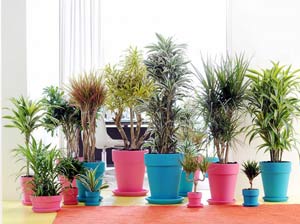 Answer: I have exactly the same problem, and it looks like you and I are not the only ones. But no matter how much I searched - or asked, no one knows what it is. There are suggestions that there is too much sun, too dry air and stuff like that. Just in case, I sprayed mine with fitoverm and actellik, although I did not find any pests. Even transplanted just in case in new ground. It is close to the window, but not in the sun. I spray constantly. If new spots appear very slowly - I do not notice. It is possible that these plants, brought from Holland (not necessarily dracaena), are treated with some kind of special tool in order to protect and strengthen them. In combination with our conditions of detention (hard water, dry air, pests), this product does not give the desired effect. That is, it does not benefit the plant, but harms it. And the plant reacts in this way.
Answer: I have exactly the same problem, and it looks like you and I are not the only ones. But no matter how much I searched - or asked, no one knows what it is. There are suggestions that there is too much sun, too dry air and stuff like that. Just in case, I sprayed mine with fitoverm and actellik, although I did not find any pests. Even transplanted just in case in new ground. It is close to the window, but not in the sun. I spray constantly. If new spots appear very slowly - I do not notice. It is possible that these plants, brought from Holland (not necessarily dracaena), are treated with some kind of special tool in order to protect and strengthen them. In combination with our conditions of detention (hard water, dry air, pests), this product does not give the desired effect. That is, it does not benefit the plant, but harms it. And the plant reacts in this way.
7. Dracena marginata for 3 years. During all this time, it seems to me, she has grown no more than 3-5 cm. I transplant it every year, fertilize, water it. True, the leaves grow very well and densely. What to do to make the palm tree taller?
Answer: this is a rarity, usually dracaena of the same species, after transplanting into a large pot, grow up to 2 meters in 2 years and the plant has to be cut. Think about it - do you need such a tall plant? If in general the dracaena looks healthy, do not rush things.
Answer: Similar symptoms occur with a lack of nutrition (poor soil or dead roots). And some soil-dwelling insects could be in the soil in the state of larvae, and then grow. Or, if transplanted, then the soil could be infected.
Yellow spots in dracaena appear from too bright sun. And the tips dry from dry air or insufficient watering. Yes, more yellow spots could be shields! Look at the underside of the leaves.
9. I have a problem - I recently found brown spots on the leaves of dracaena, there are several on two leaves. Not a shield, that's for sure. The spots are not dry, and not weeping, they are scattered over the sheet. Dracaena lives with me for a year, did not change the conditions of detention, it stands in one place from the very beginning (I spray it at least 2 times a day). What could it be?
Answer: Such spots may appear after the earthen coma has dried out (in winter). Do you dry out your dracaena? The top layer of soil should dry out between waterings, but not the whole lump.
10. At dracaena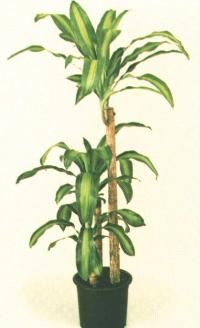 The leaves are shedding a lot. If earlier they were single, now they are whole bunches of leaves. The branches seem to dry up. The edges of the leaves are not dry, but in the center of some I found large spots.
The leaves are shedding a lot. If earlier they were single, now they are whole bunches of leaves. The branches seem to dry up. The edges of the leaves are not dry, but in the center of some I found large spots.
Answer: In my opinion, all the symptoms of overflow. Look at the roots, if there are healthy ones, cut off the rotten ones to a healthy place, sprinkle the cut with charcoal. If all the roots are rotted, you can try to root the top.
11. Yellow spots appeared on about a third of all leaves, including several on the top. It was terrible against the background of lush greenery, yellow and black. True, these spots were more and more along the edges, but on some leaves they were also in the center.
Answer: Maybe the whole thing is in the ground, if it is a dracaena bent. They are capricious, do not tolerate peat, which all ready-made purchased mixtures consist of.
12. Help, pale yellow spots appeared on 4 young leaves of dracaena different shapes: somewhere round, somewhere irregular, merging, as if faded, but there were green leaves. It is only on one top, on the other two everything is clear.
Answer: Maybe it's all about the bright sun, it could be sunburn. Dracaena needs diffused light.
13. I have had dracaena (marginata, naturally) since December, and after a week the tips of the leaves began to dry quite strongly. I raised the humidity, transplanted. Now the dracenka regularly throws out new leaves, everything is in order with them, but the old ones are still drying.
Answer: It depends on how fast, if one sheet in 3-4 weeks, then this is normal, but if there are a lot at once, then this is wrong.
14. Please tell me why the tips of the leaves turn black on the dracaena? Low air humidity?
Answer: From the dryness of the air, the tips turn yellow and dry, and most likely turn black from excessive watering, especially if it is standing on a cold windowsill. In winter, watering should be very careful.
15. Dracaena, bought a month ago, stood, not transplanted, everything seems to be fine. And suddenly, within a week, everything literally crumbled, the leaves are clean, not sluggish, without spots, they just hang, and then fall off at their base. I did reseat it, but it didn't help. There are three stems left. I cut them off carefully - now I'm waiting, will it wither or let new ones come out. What it is?
Answer: It looks like a problem with the roots - this situation is usually observed during rooting, when the roots are not yet there or they are weak. It is possible that your roots have rotted. What soil is the plant in? How often do you water it? When transplanting, did you examine the roots? If the root system has rotted hopelessly, then you can cut everything, leave only the trunks and root them again, this is easily done in sandy soil with lower heating and high humidity air.
16. Dracaena has grown, somehow you need to form a crown, but I don’t know how to do it.
Answer: You can do this: cut off the leafy part of the trunk so that 4-5 leaves remain on the "stump". Sprinkle the cut with charcoal and wait. The stump will give lateral processes and leave what you like from them. And the cut crown can be rooted directly in the ground under a cap (under a jar or a plastic bag). And I also want to add: you need to cut off the top so that the green stem remains on the “stump” along with the leaves, and when forming, as a shaper for the divergence of the trunks, you can use an ordinary ball with threads of the desired diameter inserted between the trunks.
May they always delight you with their beauty!